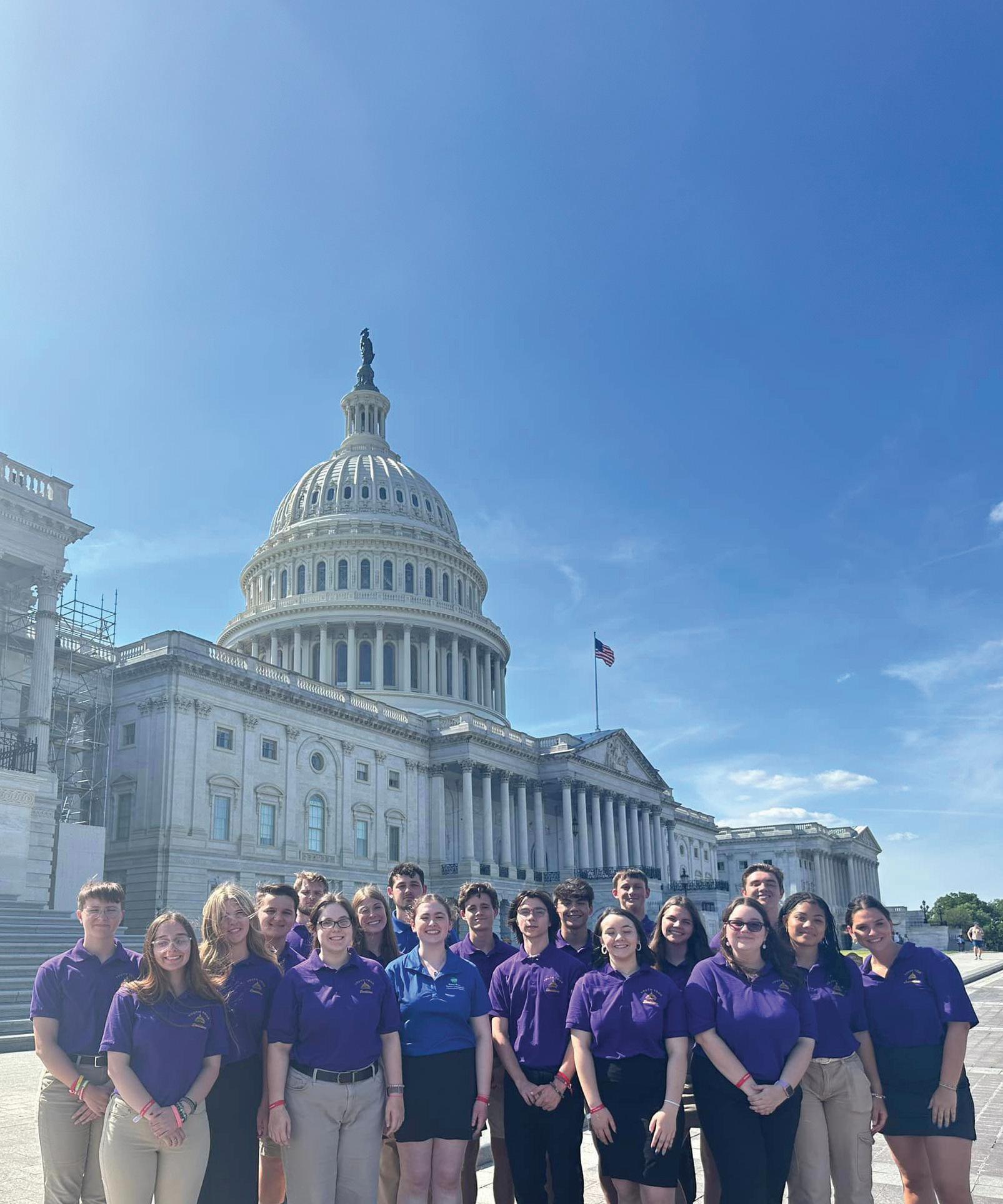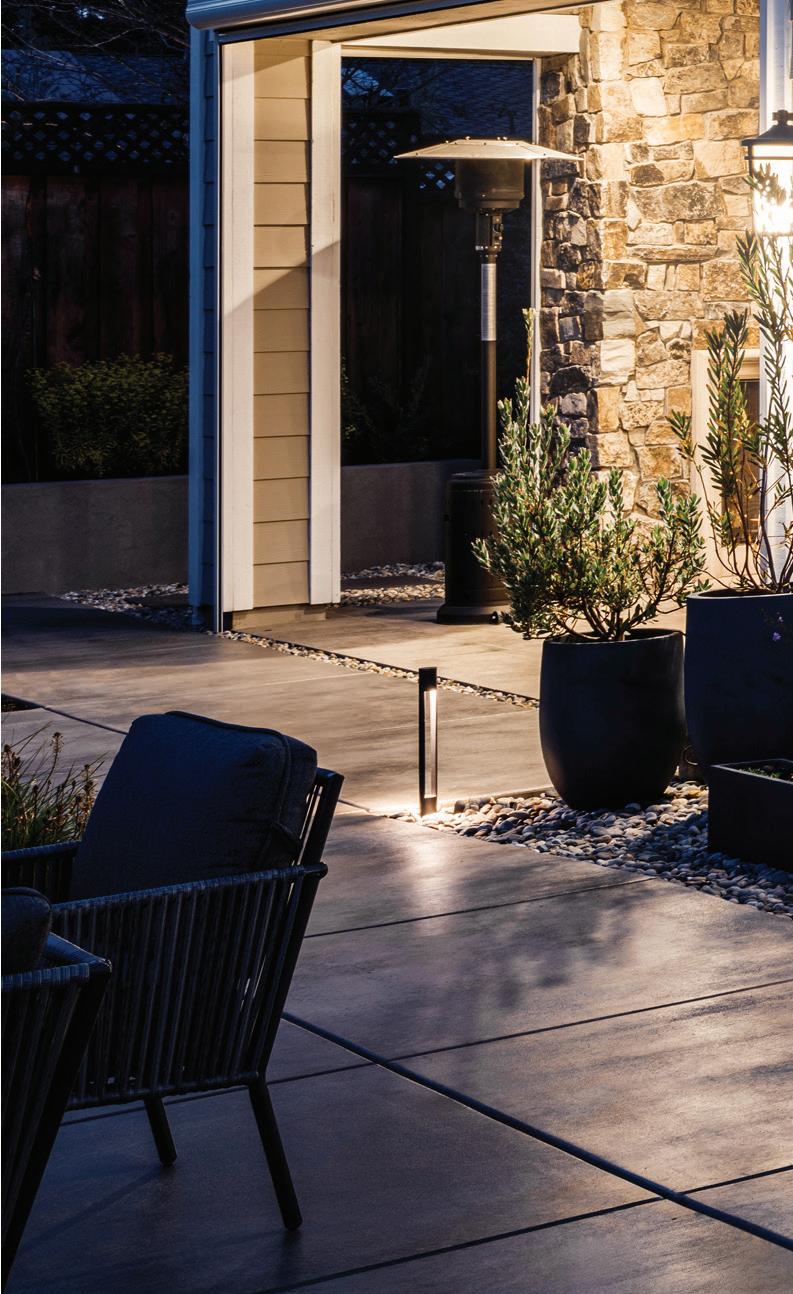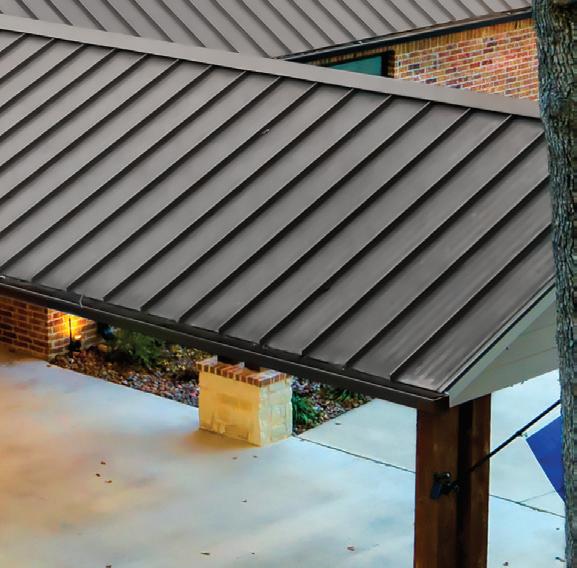Louisiana Country



Grant Christmas Tree Farm stays in the family with Gray and Mollie Anderson Page 20

Tucked into Beauregard Electric Cooperative’s community is Grant Christmas Tree Farm with family history as rich as the cane syrup produced on-site. PHOTO COURTESY OF KAYLA JADE PHOTOGRAPHY






















































There’s something timeless and heartwarming about a small-town Christmas, where life slows down and the holiday season celebrates community, tradition and the beauty of simple pleasures. That quiet, sacred pause—where everything feels peaceful and full of possibilities—reminds us of what Christmas in a rural town is truly about.
It’s when old friends and relatives come home for the holidays, gathering around kitchen tables for warm cups of coffee and conversation. Neighbors stop by with homemade cookies, and everyone knows everyone’s name.
Your Louisiana electric cooperatives and local businesses are the backbone of your community. Electric cooperatives are more than just electric utility companies; local businesses are more than just stores—we’re part of the social fabric.
When you step into a local shop, you’re not just making a purchase—you’re supporting a dream. The person behind the counter isn’t a faceless corporation but someone who likely lives nearby, whose children might go to school with yours, and who has invested their heart and soul into creating something meaningful for the community.
There’s a kind of magic that happens when you shop local during the holidays. The shops are often beautifully decorated, with window displays inviting you in with a warmth and charm you won’t find in chain stores. Local shop owners take pride in curating unique, handcrafted items that reflect the town’s personality. Whether it’s artisan candles, locally made pottery or hand-knitted scarves, the gifts you find are often one-of-a-kind, with stories behind them that make them even more special.


Farmers markets, craft fairs and pop-up shops spring up around the holidays, offering even more opportunities to find local treasures. These events make holiday shopping fun and give you a chance to support multiple small businesses in one place. They also showcase the incredible talent within your community, reminding us all that creativity and craftsmanship are right around the corner.
Your local electric cooperative and small-business owners together are the local economic drivers that strengthen and unite our communities. When our small businesses thrive, our entire community benefits.
No matter how far we’ve traveled or how long we’ve been away, the holidays pull us back to where it all began. For many, home isn’t just a physical location— it’s a feeling, a sense of belonging, a place where memories live and love never leaves.
This holiday season, I urge you to support local businesses to help create a thriving local economy. Your Louisiana electric cooperatives believe we can achieve great things by supporting each other and building a brighter future for everyone.
I wish you and your loved ones a joyful holiday season.
CEO Addie Armato
SAFETY COORDINATORS Ricky Melancon Derek Seal
COMMUNICATIONS AND DIGITAL MARKETING
SPECIALIST Conley Bourgeois
ADMINISTRATIVE ASSISTANT Rhianna Garon
CREDIT UNION
Tanya Carroll, manager
Jody Overhultz, representative
President Michael Heinen
Vice President Roger Dale DeHart
Secretary/Treasurer Richard Sitman


BEAUREGARD
Trent Buxton Kevin Turner
CLAIBORNE
Mike Marcotte Lane Davidson DEMCO
Daniel Berthelot Richard “Dickie” Sitman
Michael Heinen Byron Hardee
Trevor Benoit Roger Dale DeHart WASHINGTONST.
Joe Jarrell Dennis Glass
Associate










BOARD OF DIRECTORS
Donald Bush | District One
Ricky Deggs | District Two
J.R. Hickman | District Three
Alan Dane Slaydon | District Four
Joey Rogers | District Five
Trent Buxton | District Six
Doug Sonnier | District Seven
Diana Backhaus | District Eight
Tommy Cryar | District Nine
BEAUREGARD ELECTRIC CO-OP LEADERSHIP
Kevin Turner | Acting Interim General Manager
Kay Fox | Vice President of Marketing and Member Services
Kelly Lewis | Vice President of Finance and Corporate Services
Kevin Aycock | Vice President of Engineering and Technical Services
Scott Deshotel | Vice President of Operations and Construction Services
BEAUREGARD ELECTRIC OFFICES
Main office
1010 E. 1st St.
DeRidder, LA 70634
Phone: 800-367-0275
Moss Bluff
975 N. Perkins Ferry Road
Lake Charles, LA 70611
Phone: 337-855-6684
New Llano
12542 Lake Charles Hwy.
Leesville, LA 71446
Phone: 337-239-3451
www.beci.org
Volume 41, Issue 6
Louisiana Country (USPS 473-180) is published bimonthly by the Association of Louisiana Electric Co-ops Inc., 10725 Airline Hwy., Baton Rouge, LA 70816, in partnership with Pioneer Utility Resources. Annual Subscriptions: Members $2.59. Nonmembers $5.
Postmaster: Send form 3579 to 10725 Airline Hwy. Baton Rouge, LA 70816.
Periodicals postage paid at Baton Rouge, Louisiana 70821 and additional mailing offices.
BECi’s core job is keeping the lights on, but our passion is serving members. Because we’re a co-op, our purpose is to enrich the lives of our members and serve the long-term interests of our community. This focus on service is at the heart of who we are.
We were built and led by the members we serve. Our co-op puts people first—not just during tough times but all the time.
Over the years, our charitable efforts, staff volunteer service hours and other projects have supported local schools, young people and food banks, and assisted families in need to keep the lights on and much more.
The money we’ve spent stays right here in our service area and benefits our local economy.
We’ve invested in the infrastructure of our co-op and community to ensure the long-term viability of both. When the co-op thrives, our community thrives.
Technology such as the BECi app offers more options to track energy use and help manage the costs that are under members’ control.
As a local business, we are proud of our role in helping bring good things to our community. While the larger environment in which we operate is constantly changing, one thing remains constant. Working together with you, the members we serve, will continue to be a catalyst for good.
From my family to yours, we wish you a safe and merry holiday season.


BECi offices are closed Nov. 28-29 for Thanksgiving and Dec. 24-25 for Christmas.
Beauregard Electric offers its members an opportunity to win the co-op’s Lucky Account Number Contest by publishing four account numbers somewhere on pages 20-21 of Louisiana Country. The account numbers are listed within the story on those pages, not on the magazine cover. To win, you must locate your account number (listed on your electric bill) on these pages and then contact the co-op. To claim your prize, call 800-367-0275 or 337-463-6221 by Dec. 15.

By Curt Iles
Taps. There’s nothing quite like the sound of “Taps” echoing off a stand of tall pines.
My friend Randy Sanchez plays “Taps” on a small World War I “trench” bugle in the far corner of the Dry Creek Cemetery. The antique bugle’s unique, raw sound, which no trumpet can replicate, sends a chill through the air.
It’s appropriate because we’re bringing a Dry Creek soldier home today. Andrew Jackson Wagnon will now have a marker beside his wife, Nancy.
This spot in Dry Creek Cemetery doesn’t contain Andrew’s remains. He was buried in 1863 in an unmarked grave near Opelousas, Louisiana.
It’s only a symbolic granite marker, but regardless, we’re bringing him home today. We’re placing a marker by his wife, Nancy. It’ll be a testimony that a man named Andrew J. Wagnon walked on this Earth.
We’re doing the right thing today, and that’s what we try to do in the Piney Woods. The right thing.
The words on the marker are simple and brief, and they tell an uncompleted story:
Lost at War
Andrew J. Wagnon
1824-1863
Co A Spaight’s Batt Tex, CSA
The Ceremony
It’s a cool September morning as a group of 30 Wagnon descendants cluster around the new marker.
I’m one of them.
Andrew and his wife, Nancy, were my great-great-greatgrandparents, making me a sixth-generation descendant of these Dry Creek pioneers.
As we stand around this marker, my paternal aunt, JoAnn Iles Edwards, traces the long journey of the Wagnons as they pull up stakes and leave western Georgia, headed to Louisiana’s No Man’s Land for free land and elbow room.
We learn of the Wagnons’ arrival in Dry Creek along with two other Georgia families, the Lyleses and Hendersons. All three families still have deep roots in the Pineywoods.
In about 1892, John Wesley Wagnon married Sarah Lyles. They homesteaded a 120-acre plot and built a log cabin.
The Old House at Dusk
We call that cabin the Old House, and the Iles-Wagnon Clan still considers it the center of our universe.
That open spot in Dry Creek Cemetery, between Nancy Wagnon and her son, Jasper, has always bothered me. Last year, I stood there with cemetery board member Larry Singleton and lamented how Andrew should have a marker.
Larry went to work. Even after the Department of Veterans

Affairs turned him down, he kept digging. He is a serious historian and researcher. He was able to track down Andrew’s military service with a Texas unit nicknamed “Spaight’s Angels,” who fought the invading Yankees at Sabine Pass and Calcasieu Pass.
Larry procured the marker, flags and more for the dedication. This day wouldn’t have happened without Larry Singleton.
Today’s dedication ceremony isn’t about the Confederacy or the Civil War.
It’s about a family bringing their Dry Creek soldier home.
It’s about time to do this. It’s been more than 160 years since Andrew left Dry Creek for the war, never to return, dying of typhoid fever while encamped near Opelousas.
It’s a sobering fact that more Civil War soldiers died of disease than bullets.
Andrew’s Marker
We’re placing Andrew’s marker beside his wife, Nancy, who lived 49 years as a war widow until she died in 1912.
Two noteworthy events take place during the ceremony.
The first is that Larry Singleton presents a Texas flag to Levi Wagnon, a junior at East Beauregard. Levi, a seventh-generation descendant, represents the Wagnon clan.
Next, we say the Pledge of Allegiance.
It may seem ironic that we recite the pledge at the marker of a rebel soldier who took up arms against the United States.
Here’s what I tell our family: “I want you to look around this cemetery. Every person buried here is an American, and that includes Andrew and the other 15 Confederate veterans buried here. We’re all Americans.”
We said the pledge together.
As I said earlier, it was the right thing to do.
Andrew won’t be forgotten to history.
We brought a soldier home to Dry Creek.
May he rest in peace.
Curt’s latest book, “Where I Come,” is available at Amazon and Kindle.

National Rural Electric Cooperative Association Youth Tour is a weeklong trip sightseeing, learning about the cooperative business model, meeting Louisiana legislators and making friends from across the state and country.
This year’s delegates represent Beauregard Electric Cooperative Inc., DEMCO, Jeff Davis Electric Cooperative, South Louisiana Electric Cooperative Association and Washington-St. Tammany Electric Cooperative.
“This trip never fails to amaze me,” says Conley Bourgeois, director of the Association of Louisiana Electric Cooperatives Youth Tour. “Watching the delegates experience the sights of our nation’s capital and create lifelong memories is incredibly rewarding.”
Andrew Nguyen, JDEC
Anthony Plaisance, SLECA
Brenna George, BECi
Delasya Guinn, DEMCO
Emily Doerr, DEMCO
Halle Harrell, DEMCO
Hudson Carter, JDEC
Isabella Winter, DEMCO
Jaden Lebo, WSTE
Jaylon Stephens, BECi
Lauren Malbrough, SLECA
Lucian Gaspard, BECi
Madelyn Bailey, BECi
Nicholas Wadsack, DEMCO
Remy Boudreaux, DEMCO
Tuyen Helms, WSTE




2025 Youth Tour June 14-21



FOR MORE INFORMATION: www.alec.coop/public-relations-education/youth-tour





sights we saw:
• Albert Einstein Memorial
• Arlington National Cemetery
• Ford’s Theatre
• Franklin Delano Roosevelt Memorial


• United States Holocaust Memorial Museum
• U.S. Marine Corps War Memorial and Sunset Parade
• Lincoln Memorial
• Mount Vernon
• National Mall
• U.S. Capitol Tour



“The Youth Tour Trip was so impactful. I’ve made lifelong friends who are like-minded and similar to me. I got to come face-to- face with historic landmarks I have only dreamed of seeing in person. I’m so thankful to have been given this opportunity, and I hope many others experience this as well. It’s such an incredible experience, and I will remember it forever!”
Isabella Winter, DEMCO
“Once-in-a-lifetime experience.”
Brenna George, BECi

“My time in Washington, D.C., was nothing short of life-changing. I was given the opportunity to explore and collaborate with likeminded youth from all around the United States.”

Anthony Plaisance, SLECA










To all the men and women who have served our country, but especially our very own, happy Veterans Day. PHOTO COURTESY OF BECI
Required by 39 USC 3685
Filed with the USPS on 9-23-24
LOUISIANA COUNTRY (publication number 473-180) is published bimonthly by the Association of Louisiana Electric Cooperatives Inc., 10725 Airline Highway, Baton Rouge, LA 70816. Six issues are published annually, with a subscription price of $2.59 paid by utility members in their electric bills.
The name and complete mailing address of the publisher is Association of Louisiana Electric Cooperatives Inc., 10725 Airline Highway, Baton Rouge, LA 70816.
The name and complete mailing address of the editor is Addie Armato, 10725 Airline Highway, Baton Rouge, LA 70816.
The owner is the Association of Louisiana Electric Cooperatives. There are no known bondholders or other security holders.
ALEC is a nonprofit organization mailing under DMM Section 423.12. Its purpose, function and nonprofit status for federal income tax purposes has not changed in the preceding 12 months.
The average number of copies of each issue during the preceding 12 months are:
The holiday season is just around the corner. Festive music will soon flood the airwaves, sparkling lights and decorations will adorn homes and businesses, and good tidings will abound.
The holidays also bring a frenzy of decorating, cooking and family gatherings. Amid the hectic hustle and bustle, you may receive higher-than-usual energy bills.
Keeping this in mind, this month is a good time to remind co-op members of a few programs and efficiency tips to help lower their monthly energy use.
Winter months typically bring some of the highest energy bills of the year. Making minor, low-cost improvements, such as weatherstripping exterior doors and caulking around old, drafty windows, can make a positive impact on energy bills.
Your cooperative’s team of member service representatives is available to help. We encourage you to call to learn about programs and services that can lower your bills.
Some of us bring the Christmas decorations down from the attic faster than we can finish the Thanksgiving turkey. With holiday lights adorning our home for more than a month, it’s a good time to make the switch to LEDs to save energy.
LED holiday lights use 88% less energy than incandescent holiday lights. To put that into perspective, the Department of Energy estimates, with standard holiday decorations, LED lights typically increase energy bills by $5 to $7. However, with incandescent lights, energy bills will typically increase by at least $33.
For homes that go above and beyond with incandescent holiday lighting (think Clark Griswold), energy bills could



increase by as much as $350. Beyond providing energy savings, LEDs are shock-resistant, shatterproof and cool to the touch, making them safer for the home.









You can also lower energy use by conveniently managing holiday lighting. Smart light timers can help you save energy by connecting to a smart phone app or voice assistant to program lights to turn on and off at set times. If you don’t use smart home technology, you can still save energy by using traditional timers.












Additional easy ways to save during the holiday season include turning off overhead lights and using your Christmas tree to illuminate your home. If you have a fireplace, remember to close the flue when a fire isn’t burning to ensure heat doesn’t escape through the chimney.








If you plan to have family and friends over this holiday season, you can save energy by using small countertop appliances like microwaves, air fryers and slow cookers when possible, as they use much less energy than the stovetop or oven.











When using the oven, bake multiple dishes at once for maximum efficiency. It takes as much energy to cook one dish as it does to cook several.
Turn off the oven a few minutes before the recipe’s end time and allow the residual heat to finish baking the dish. Once the food is done, leave the stove door ajar to allow the residual heat to warm the room.
When using the stovetop, match the pan size to the burner to maximize the stovetop’s efficiency.
Try a few of these helpful tips as we approach the holiday season. With a little planning, you can find efficient ways to save on everything from holiday decor to your favorite soup recipes.
Best wishes for a wonderful holiday season.
By Cheré Coen











Like many native-born Louisianans, chef Sheri L. Raleigh learned to cook by watching her mother and grandmother in the kitchen. The graduate of Boston High School in Lake Charles and Northwestern State University in Natchitoches went on to a professional career in child nutrition in Texas, but Sheri never forgot her roots.

An administrator and educator in public schools for 35 years, she established Cast Iron Skillet Culinaire in 2012 to teach cooking classes for various educational, hospitality and health care organizations in Waco, Texas. When she began leading classes at a community college, her department head asked if she would include African cuisine.
Sheri says the request was timely since African culinary origins include Creole cuisine, and she had a side project.






“I was working on genealogy at the time with my cousin. She suggested putting the food recipes with the genealogy.”
Sheri reached out to chef Pierre Thiam from Senegal and other African culinary experts, and she examined the African influences in both Southern and Creole cuisines.
“And then I was able to build a curriculum from that,” she says. It also led to her Gifts from the Ancestors program, a 2022 project she developed that includes a five-part series on








YouTube exploring West African culinary influences in American dishes. She taught a class at Shadows-on-the-Teche in New Iberia, sponsored by that city’s African American Historical Society.
“There are a lot of crossover influences,” Sheri says of West African foodways and Louisiana’s cuisine. “They’re very similar. You find a lot of recipes that I say are kissing cousins.”
For example, a West African dish combines ginger shrimp with a tomato sauce made with palm nut oil and stewed tomatoes, similar to Louisiana shrimp Creole. A rice dish that resembles Louisiana-style jambalaya includes jollof rice. Louisiana gumbo, depending on how it’s made, has its roots in West Africa—gumbo is Swahili for okra, a vegetable that’s part of the hibiscus family and is used in Indian, African and Middle Eastern cuisine, Sheri says.
For her New Iberia class, Sheri prepared a sweet potato peanut soup popular in West Africa.
“They use peanut butter to thicken the soup like we use a roux to thicken,” she says. “The texture’s like velvet.”
Sheri is compiling a digital cookbook of the African versions of Creole dishes.
The proceeds from the cookbook sales will help fund the Lawrence J. and Viola M. Raleigh Education Fund, benefiting aspiring Black female chefs in collaboration with the Texas Restaurant Association Foundation.
For more information on Sheri’s work, visit giftsfromtheancestors.com. She can be heard as a featured guest on the “Freestyle Flavor” and “Cookbook Love” podcasts and is the founder of @blackwomenchefs on Instagram.

1 pound chicken breasts, boneless and skinless
½ teaspoon cayenne pepper
Salt, to taste
3 teaspoons extra-virgin olive oil
1 cup onion, medium diced
1 cup green onion, small diced
1 cup celery, medium diced
1 cup bell pepper, finely diced
2 tablespoons butter
2 cloves garlic, minced
1 can tomato paste or 2 cans tomato sauce
1 cup chicken or seafood broth
1 can small-diced tomatoes
1 tablespoon creole seasoning
1 pound shrimp, peeled, deveined and rinsed
1 pound andouille sausage, cut in diagonal coins
3 cups dry rice, cooked
Season chicken breast with salt and cayenne pepper. In a large skillet, heat olive oil and pan-fry chicken until lightly browned on each side. Remove from pan and cut into 2-inch cubes. Set aside.
Saute prepared onions, green onions, celery and bell pepper in pan drippings. Add butter and cook vegetables until clear and tender. Add tomato paste or tomato sauce, chicken or seafood stock, diced tomatoes, minced garlic, creole seasoning and additional salt, to taste. Stir and simmer for 15 minutes.
Gradually add shrimp, chicken and sausage. Cook until the shrimp are pink.
Spoon the jambalaya mixture onto cooked fluffy rice.
Sheri’s jambalaya is full of authentic flavors.
By Cheré Coen

Before Austin Clark moved to Baton Rouge from Atlanta, a member of his weavers’ guild sent him off with a plant that would change his life.
“My parting gift from her was Acadian brown cotton,” Austin says.
The cotton, used by early Cajuns, sent Austin on a research mission, which led to a mentorship by Cajun weaver Elaine Bourque, herself a student of award-winning weaver Gladys Clark. Austin now grows indigo as a traditional Louisiana dye and brown cotton to weave when he’s not working as associate organist at Baton Rouge’s St. James Episcopal Church.
Austin says historic Cajun weaving is a tradition that has been passed down to him.
"My goal is to continue that tradition," he says.
Austin’s textiles have been included in art exhibits and won the craft category for the 2022 Made in the South awards by Garden and Gun magazine. He befriended Norman Kennedy, a master weaver who twice won the National Endowment for the Arts National Heritage Fellow.
“He does a road trip every winter through the U.S.,” Austin says. “He would end up in Louisiana because he loved the Cajuns and loved their traditions.”
Norman opened the world of teaching to Austin, who now instructs weavers at Vermont’s Marshfield School of Weaving and the John C.





Campbell Folk School of North Carolina.
Austin’s blankets and other textiles made in the Louisiana tradition are in hot demand. He sells his wares through his website, but he says they go fast, usually right after he announces the available item in his newsletter. They’re not cheap, but the price tag reflects the hours that go into weaving: 100 hours per blanket. His process includes picking the cotton, then ginning, cording and spinning the cotton into thread. He must set up the loom, weave the blanket and then sew.
“Hand weaving is slow,” he says. “It’s a lot of steps.”
Elaine and Austin are collaborating on a book about Cajun textiles, painstakingly researching the Cajun weaving tradition dating back 250 years.
And it all started with a gift from a friend.
“There’s not a drop of Cajun in my blood, but once it found me, I couldn’t let it go,” Austin says. “It’s all because of brown cotton.”
Austin is one of many Louisiana artisans producing unique pieces, many of which require skills passed down through generations. Some craftspeople produce instruments similar to the accordions and fiddles used in Cajun and Creole music.
Others, like Iota’s Jackie Miller, began making costumes and capuchons, the tall conical hats worn by riders on horseback for the annual Cajun Courir de Mardi Gras. Jackie took up the art when her children were young and participated in the nearby Egan Mardi Gras. She later began sewing for adult members of regional krewes.
Some artisans lean toward modern designs, such as Mandeville woodworker Robert Johnson, who specializes in wooden kitchen utensils, or Betsy Meyers’ “art to wear” handcrafted jewelry.
There are about 250 members of the Louisiana Crafts Guild, according to board member and mixed media artist Terry Palmer.





Around 150 of them exhibit at the flagship store Sans Souci Fine Crafts Gallery in Lafayette and La Guild in Canal Place shopping center in downtown New Orleans. Art ranges from paintings and photography to Catherine Myers transforming Louisiana mud and clay—occasionally from crawfish chimneys—into bowls, vases and ceramic animals. A jury must approve members to participate.
Sometimes it’s a family affair. Pat and André Juneau create vibrant folk art aluminum metal pieces seen all over Acadiana. The family, residents of Scott, includes Suzanne and Angelique Juneau, a mother-daughter team working in whimsical metal jewelry. André is president of the Louisiana Crafts Guild.
Marc Savoy is an artisan honoring his roots. The Eunice native began building Cajun-style accordions as a hobby in 1960, back when he says Cajun wasn’t cool. That didn’t dissuade Marc from taking out a loan to build Savoy Music Center on his grandfather’s property in Eunice. It opened in 1966, but even the loan officer, along with his friends, doubted Marc would succeed.

Since those early days, musicians from around the world have bought Marc’s instruments and traveled to perform at his weekly jam sessions at Savoy Music Center. Marc has traveled the globe performing with numerous Cajun musicians and with Savoy Family Band, which includes his wife, Ann, and sons, Joel and Wilson. Marc is a recipient of a 1992 National Heritage Fellowship by the National Endowment for the Arts, has appeared on the Public Broadcasting Service documentary series “American Roots” and is a proud promoter of Cajun culture.
On the contemporary side, Terry’s artwork blends painted and burned woodwork accented by raku-fired ceramics. His work was recently exhibited at Acadiana Center for the Arts, including the signature piece “Case of Coke Heads,” featuring a Coca-Cola case full of miniature ceramic heads.
“It’s hard to describe because you’ll not see anything like it,” Terry says of his contemporary artwork, adding that he sometimes adds coyote or sheep skulls to the pieces. “They’re kind of dark sometimes.”

Terry grew up in Prairieville and received his degree in graphic design from the University of Southwestern Louisiana, now the University of Louisiana at Lafayette. He and his wife, Simone, own and operate Palmer Graphics.
Over in Sunset, the quaint town breathes antiques and artists, its streets lined with shops offering one-of-a-kind items, whether recycled or newly created.
Stepping inside Jerilyn’s Fused Glass Art Gallery & Studio on the main street of Sunset is like walking through a rainbow with colorful glass creations hanging from the ceiling, decorating the walls and quaint small items such as garden stakes and fused glass pieces resting on shelves. It’s difficult not to smile at the glass art of Jerilyn Guidry LaVergne, especially when the glass chimes are set into motion and a symphony ensues. Don't hesitate to do so, because Jerilyn swears each piece is indestructible.
These are just a few of the state’s talented artisans producing both historic and contemporary artwork. To view a few of the members’ works at the Louisiana Crafts Guild, visit louisianacrafts.org.


LEFT: Jerilyn Guidry LaVergne’s glass chimes create beautiful sounds.
BELOW: Jerilyn’s Fused Glass Art Gallery & Studio brings a splash of color to Sunset. PHOTOS COURTESY OF JERILYN GUIDRY LAVERGNE

Baton Rouge Arts Market, ongoing
The Baton Rouge Arts Market, also called BRAM, is open from 8 a.m. to noon on the first Saturday of each month, with the Red Stick Farmers Market at Fifth and Main streets in downtown Baton Rouge. artsbr.org/arts-market
New Orleans Jazz and Heritage Festival, last weekend in April, first weekend in May
Jazz Fest offers three markets for curated artists: Congo Square African Marketplace, Contemporary Crafts and Louisiana Marketplace. nojazzfest.com/crafts
Festival International de Louisiane, last weekend in April
Festival International takes over downtown Lafayette for five days and includes visual arts displays and vendors in addition to its musical stages.
festivalinternational.org
Lake Charles Arts & Humanities Council’s Spring Art Walk
Spring Art Walk through downtown Lake Charles features more than 60 local artists and artisans. artscouncilswla.org/events/gallery-promenade
Natchitoches-NSU Folk Festival, July
Louisiana traditional artists and musicians are honored every July in Natchitoches, plus the festival offers the annual Louisiana State Fiddle Championship and traditional material culture demonstrations. nsula.edu
Lake Charles Arts & Humanities Council’s Gallery Promenade, August
Downtown Lake Charles businesses are paired with local artists showcasing their work. artscouncilswla.org/events/gallery-promenade
Festivals Acadiens et Créole, October
This Lafayette festival is plural for a reason—the event combines several festivals into one, including the Louisiana Craft Fair, which features local artists and artisans. festivalsacadiens.com
Washington Parish Free Fair, October
In addition to all that a parish fair typically offers are nods to artists and artisans. freefair.com
Covington Three Rivers Art Festival, Nov. 9-10
A juried event featuring 200 artists and artisans takes over several city blocks in downtown Covington every fall. Works in every medium are represented. covingtonthreeriversartfestival.com





































In accordance with the BECi Bylaws, the Board of Directors will approve a call for nomination by petition at the Dec. 10, 2024, board meeting. The announcement is the beginning of a process for the election of three (3) board members (one each from districts 5,6 and 8) in March 2025. Three board members will seek reelection to serve another three-year term. The current directors are Joey Rogers, of Oakdale, District 5; Trent Buxton, of DeQuincy, District 6; and Diana Backhaus, of Sulphur, District 8. The procedure and schedule for the process are as follows:
2025 Election Information
• One director each is to be elected in District 5, District 6 and District 8.

• All nominations are to be by petition. Official petition forms and instructions will be available beginning Thursday, Jan. 2, 2025.

• Petitions must be delivered to the BECi DeRidder Office no later than 9:30 a.m. Thursday, Jan. 16, 2025.

• The names of nominees will be posted at BECi offices by Thursday, Jan. 23, 2025.
• The membership cut-off date to be eligible to vote is Tuesday, Jan. 21, 2025.

• Ballots may be mailed no earlier than Feb. 15, 2025, and no later than March 12, 2025.

• Deadline to receive ballots and releasing results will be announced.
• The BECi Annual Meeting will be Saturday, March 22, 2025.


Contact: Kay Fox
Beauregard Electric Cooperative, Inc.
337-463-6221, ext. 8367


1-800-367-0275







Ricky Melancon, safety and training coordinator for the Association of Louisiana Electric Cooperatives, has completed an intensive electric utility safety and loss control program.
The Certified Loss Control Program is a series of workshops offered by the National Rural Electric Cooperative Association in conjunction with the National Utility Training and Safety Education Association. The program is designed to instruct participants in many electric utility industry safety areas.
According to the Occupational Safety and Health Administration, nearly 4 million injuries occur annually in the workplace. One of the goals of a certified loss control professional is to help ensure a
safe work environment for utility workers and the general public.
Ricky is one of only a few electric utility professionals in the country who will receive this certification this year. The program requires participants to complete a rigorous series of seminars and tests, a 30-hour OSHA course and a detailed final course project.
Program participants go through four weeklong sessions designed to challenge and educate them in new, innovative safety techniques. Participants must also maintain their certificate by attending courses every year to stay on top of changes in the industry.
Ricky has been with ALEC for 2.5 years. n



































Grant Christmas Tree Farm stays in the family
By EmmaLee Tingle
Tucked along Beauregard Electric Cooperative’s lines is a Christmas tree farm with family history as rich as the cane syrup produced on-site.
Grant Christmas Tree Farm was founded in 1983 by Huey and Kathleen Bailey. Kathleen was born and raised in the area. In the early ’80s, she and Huey decided to turn some land they owned in Grant into a Christmas tree farm. They planted trees, and Grant Christmas Tree Farm was born.
At the time, Kathleen’s father was known in the community for making cane syrup. Huey learned the process from his father-in-law, and began producing cane syrup from sugar cane grown on the property.
Before long, Kathleen had the idea for live music events featuring a menu of fresh biscuits, sausage, gravy and cane syrup. Some community women who were handy with a wood cookstove helped make biscuits. The events outgrew the first cookstove, then another, before moving on to a traditional oven. Account No. 88670978001
These first days established a tradition of friends and community members playing live music and enjoying a fresh biscuit meal.
In the early days of the farm, Huey and Kathleen’s daughter, Mollie, was a high school student with a front-row seat to the farm’s beginnings. She went on to marry Gray Anderson, and they moved to Tennessee for work.
Gray and Mollie returned to Grant in 1997 after eight years away and bought the farm from her parents. With plans to keep longstanding traditions alive, they eyed additions to create a Louisiana agriculture and horticulture attraction site.



Today, the farm is a thriving venue with multiple festivals and events during the peak season—October through December.
Peak season kicks off with Pumpkin Fest at the end of October. Attendees can enjoy live music, a pumpkin patch, vendors and a large play area for children. It also serves as the opening weekend for families to wind through thousands of Christmas trees to choose, purchase and pre-tag their tree.
Trees are year-round work, and the Andersons grow and cultivate several types of cypress trees, while experimenting with new varieties. Account No. 8553001
The most popular Christmas tree variety on the farm is the leyland cypress, followed by the ovensii. Because these varieties don’t produce seeds, every tree on the farm starts as a cutting from trees already in the field.
Approximately 60,000 cuttings are planted in early spring and cared for in a rooting house for four to five months until roots form. Of these cuttings, 40,000 to 50,000 will take root. From there, they are planted in nursery pots for a year, then transferred to larger pots for a second year.
Some of the trees will be sold to other Christmas tree farms in a four-state area, and others are planted on the farm to grow in the soil for another three to four years.
In the field, the trees are trimmed three to four times per year. This process maintains their shape and helps the trees thicken. When the trees reach 6 to 8 feet tall, they are ready to sell. The farm sells around 3,000 Christmas trees every season.
“We see lots of repeat customers,” Mollie says. “We are now seeing a third generation come to the farm. Many of those customers have become friends over the years.”
The Friday after Thanksgiving kicks off the first weekend of the farm’s Christmas Festival. The festival runs for two weekends and features fun for the entire family. Local arts and crafts vendors sell products such as handmade soaps, woodworking items, macrame, pottery, and handspun products from spinners and weavers on-site.
The festival offers live music on Saturdays, a play area for children, train rides, a goat

walk, food and live demonstrations of cane syrup cooking on an old outdoor cane press. On festival afternoons, the farm continues the tradition of serving fresh biscuits and syrup to patrons. Account No. 98357001
Syrup cookies have become one of the farm’s most beloved items. Making cookies from the farm’s cane syrup was Kathleen’s idea, and customers can’t get enough of the chewy gingerbread-like treats.
“The syrup cookies really have become a signature of the farm,” Mollie says. “We make them in the summer and freeze them. This year, we made 7,000 cookies to sell this season.” Account No. 166797001
Cookies are available in the farm’s gift shop, which was a longtime dream for Mollie and Kathleen. Gray built the shop with rough-cut lumber to maintain a rustic feel. It’s stocked with ornaments, gifts, raw honey harvested from Gray’s bee colonies, cane syrup produced on the farm, fudge, various pecan products, and locally sourced jams, jellies and fruit syrups. There is also a small toy store on the premises.
During the festival’s weekends, Santa stops in to visit with children.
Children also visit the farm on school tours from October through December. Gray and Mollie develop educational programming that’s tailored to grade-level abilities and expectations.
Grant Christmas Tree Farm is a staple holiday tradition for area families, rooted in rich history and Louisiana hospitality. Families are invited to stop by, have a biscuit with syrup, find a beautiful Christmas tree and become a friend at the farm.
Is a
By Scott Flood
We depend on reliable electricity more than ever before—even the briefest service interruption can be incredibly frustrating. It’s no wonder many homeowners are taking a closer look at the latest battery-powered systems as backups during an outage.
Battery technology has advanced significantly in recent years, with batteries able to hold more electricity even as they shrink in size and cost. The same innovations that boosted the performance of electric vehicles are being engineered into today’s battery-powered backup systems.
As their name implies, battery backup systems such as Tesla’s Powerwall are essentially high-capacity batteries that store electricity you can use to power your home in the event of an outage. Some are constantly charged by the power grid, and others rely on solar panels for recharging.
Traditional standby generators use small internal combustion engines fueled by natural gas, propane or diesel. They can be connected to your home’s electrical panel and kick on automatically whenever the flow of electricity stops. Assuming you keep them refueled, most can operate for days at a time.
Some standby generators can be noisy, and nearly all produce smelly exhaust containing deadly carbon monoxide gas, so they can’t be operated indoors. Large standby generators are typically installed outdoors on a concrete pad, which may detract from your home’s curb appeal.
Most home battery backups are smaller than comparable generators. Because they
don’t use combustion to generate electricity, there’s no danger of carbon monoxide exposure. That makes them safer and more environmentally friendly than generators. Most can be installed in a small space indoors. Battery backups are also significantly quieter. When a power outage occurs, battery backups start instantly, unlike generators that may take a few moments to spool up and reach operating speed. Battery backups also don’t need regular maintenance, such as oil changes or spark plug replacement, and there’s no need to store fuel.
Of course, battery-powered generators do present some disadvantages. The amount of power they deliver is limited by the capacity of their batteries. When they’re out of electricity, they may need hours of recharging before being used again, so they’re not as well-suited for lengthy outages. Energyhungry appliances, such as air conditioners and water heaters, may drain the batteries’ capacity more quickly, so you may want to disconnect them during an outage.
Fortunately, some battery backups are modular, allowing you to add capacity as needed. If you only need a few devices powered during an outage, consider a portable battery-powered system. These small, quiet backups can be used indoors to power smaller appliances, such as your laptop, TV or microwave.
Generally, batteries require long charging times. If an initial outage is quickly followed by another, they may not be able to respond. There are fast-charging systems on the market, but they carry substantially higher price tags.




Even for a basic battery backup system, the upfront cost of a battery backup is more than a standby generator—in some cases, twice as much for comparable performance.
Like those in your mobile phones, batteries in these systems can degrade over time. In five to 10 years, they may need to be swapped out with new batteries, adding to the overall cost. Recharging battery backups with solar panels appeals to many homeowners, but the performance depends on the amount and angle of sunlight on your roof.
So, is a battery-powered backup system right for your home? The answer is different for every homeowner, but whether you’re considering a battery system or a traditional standby generator, start by calculating the amount of power you need to keep your home’s systems and conveniences operating efficiently. Once you know that,

you can determine which models are up to the task and calculate how long the device you’re considering can power your home.
If you have a family member whose health depends on devices such as a CPAP machine or supplemental oxygen, be sure to factor that into your decision.
Whether you choose a battery backup or a traditional standby generator, make sure it’s designed to protect your home and all your electronics from power surges and other issues that may damage your TVs, computers and other sensitive electronics. That way, you won’t have to worry about remaining without them long after an outage has ended.



























































